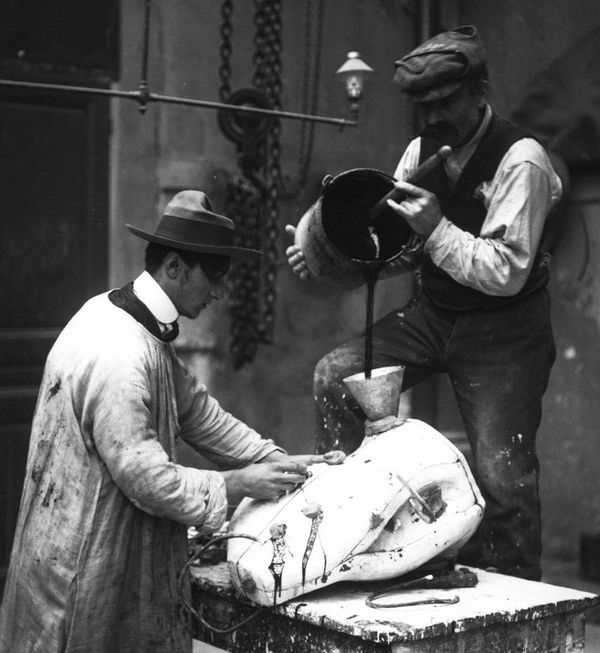Rembrandt Bugatti, “Petit Éléphant en marche”, conceived circa 1912. Design New York.
Early in his artistic career, Rembrandt Bugatti (1884–1916) was simply known as “the other Bugatti.” A son of the legendary furniture designer Carlo and the younger brother of engineering genius and car manufacturer Ettore, Rembrandt’s initial efforts as a sculptor were generally overlooked. Reclusive and painfully shy, he did little to promote his own works. However, by the time of his tragic death at the young age of thirty-one, Rembrandt Bugatti was one of the most admired sculptors in Europe.
Rembrandt Bugatti modeling another elephant sculpture at the Antwerp Zoo, 1908.
Bugatti was introduced to sculpting shortly after his family moved from Milan to Paris in 1903. A constant visitor to his father’s workshop, he was encouraged by the Russian sculptor, and family friend, Prince Paolo Troubetskoy. By 1904, Bugatti’s love of the animal kingdom was apparent and the renowned foundry and gallery owner Adrien-Aurélien Hébrard began presenting a series of annual exhibitions of his works at Galerie Hébrard and overseeing the casting of his oeuvre. It was Hébrard’s insistence on strictly limiting the number of Rembrandt’s produced pieces that helped control their superb quality and cement his burgeoning reputation as a highly sought after and uniquely gifted talent. Bugatti spent much of his time at the Jardin des Plantes zoo in Paris and by 1907 at the Antwerp Zoo in Belgium. For Rembrandt, these visits served not only as inspiration but also as refuge from human interaction and the chaotic Parisian or Belgian social scenes. At the zoos he tirelessly observed, with extraordinary empathy, how elephants, baboons, panthers, leopards, deer, hippopotamuses and other animals behaved, moved and interacted with each other and the public. Rather than return to a studio to sculpt or sketch, Bugatti could be seen at the zoo poised in front of these subjects creating his models in plasticine.
Two workers at A.A. Hébrard Foundry, 1910.
Bugatti’s passion for and understanding of each animal evolved over the years, and his sensitive portrayals of elephants in various poses are amongst his most celebrated works. Petit Éléphant en marche is an exceptional example of the artist’s creations. With an absolute mastery of the expressive potential of bronze, Bugatti captures the majesty of this divine animal, as well as the subtleties of its musculature, a glimpse at the creature’s spirit, and a spontaneity of motion. Standing tall, with a confident stride, two legs raised above the base, and curled trunk, the sculpture is imbued with energy, fluidity, emotion, and charm. The object is as hypnotic as it is powerful. The present offering is one of only eleven known casts made of the model and, as signified by the letter “M” impressed alongside the foundry mark on the base, was included in the private collection of A.A. Hébrard.
Recommended Reading


